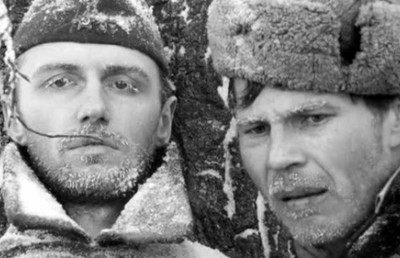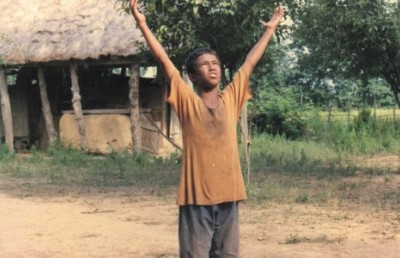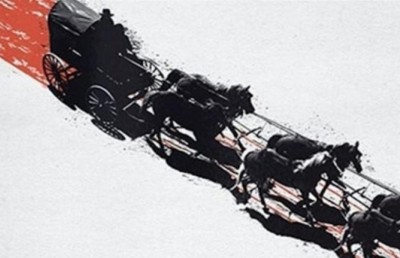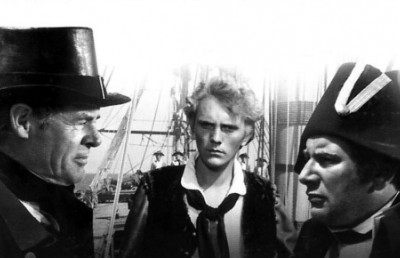Volker Schlöndorff’s Diplomatie: Dramatizing Peace
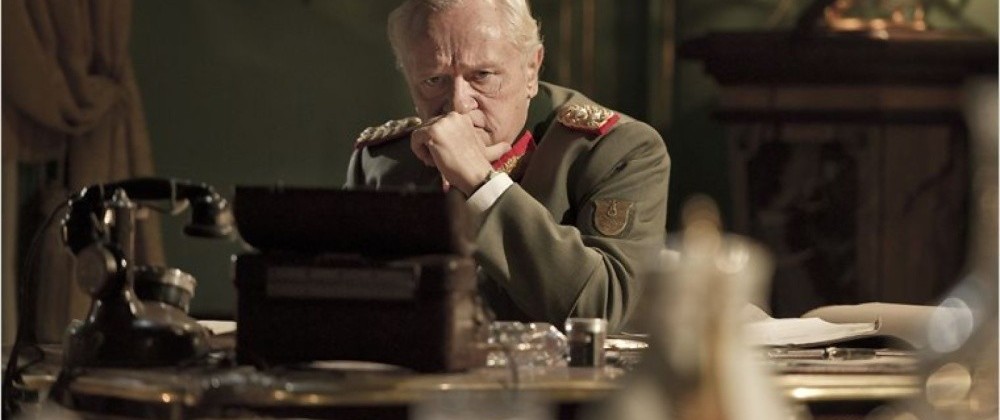
Cyril Gély’s Diplomatie might seem at first glance to be an unlikely candidate for cinematic adaptation. Although it was a success on the Paris stage in 2011, it is a single-set work consisting almost entirely of dialogue, with most of the conversation between the two central characters. Nonetheless, one can see why its producers were anxious to give it a try. It has a powerful narrative hook, telling the story of how the city of Paris may have narrowly avoided destruction near the end of WW II. Its two main characters are Dietrich von Choltitz, the general put in charge by Hitler of overseeing the city, and Raoul Nordling, the Swedish consul. In the original stage production, these actual historical men were played by two major stars of the French stage and screen, Niels Arestrup and André Dussollier, respectively. Both were willing to appear in a film adaptation.
The two central characters represent two conflicting worldviews that in the course of the play become bridged through dialogue: the military world with its physical, brutal, non-nuanced principled ethos; and the diplomatic world, grounded in the non-physical, verbal, nuanced and sophistic. At the same time, Volker Schlöndorff has staged a play that consists almost exclusively of talk whereby the film’s imagery amplifies and contextualizes its verbal discourse. Diplomatie is a film about war, yet does not glorify war. Simultaneously, it is a film about two kinds of masculinity, the masculinity of force as opposed to the masculinity of persuasion. As such, it locates this second quality in the elites rather than the lower social classes, an issue that may become problematic. If the Swede Nordling is the hero of the film, the qualities he represents turn out to be the ones that Schlöndorff prizes in presenting his argument in favor of diplomacy over violence. And like the diplomat, Schlöndorff opts for subtlety and nuance rather than bombast. We will discuss these issues—the warrior/diplomat opposition, the cinematizing of a theatrical piece, and the political and theoretical contradictions inherent in both the play and film. But let us first offer a little background about the project.
German filmmaker Volker Schlöndorff has described how he jumped at the opportunity to direct Diplomatie, which he called “a wonderful offer” (“Fassbinder”). Schlöndorff’s ties to France and its film culture extend back to his years in a French boarding school, and, even more significantly, to his time spent as an assistant to French directors such as Louis Malle, Jean-Pierre Melville, and Alain Resnais, during which he learned his craft as a filmmaker. He launched his directorial career with the Cannes Festival premier of his first feature Young Törless (1966). His 2012 film Calm at Sea corresponds to Diplomatie in that both are set in Nazi-occupied France, were financed as French/German co-productions, and were shot with parts in each of the two languages. Furthermore, throughout his over forty-year career, the director has repeatedly examined issues of guilt and responsibility during the Nazi era.
Even the theatrical adaptation aspect of the Diplomatie project was a comfortable fit for Schlöndorff. He had, for example, in 1985 successfully guided the Broadway cast of a revival of Death of a Salesman through an adaptation for American television that was, however, also meant for global cinema release. He had restaged for the camera a theatrical production of Éric-Emmanuel Schmitt’s Enigma (2005), a two-character play structurally similar to Diplomatie as a battle of wits between two men. Schlöndorff was clearly the perfect director for the project.
The narrative of Diplomatie hinges on the decision that the German general von Choltitz must make, whether to obey or disregard orders from a by now vengeance-crazed Hitler, determined to destroy the city of Paris. The topic of insubordination within the Nazi military had been treated by German filmmakers only occasionally before, in works such as Helmut Käutner’s The Devil’s General (1955) and Eberhard Fechner’s Winterspelt (1977). The specific characters of Choltitz and Nordling had appeared in René Clément’s Is Paris Burning? (1966). Clément’s approach to the liberation of Paris is an almost total opposite of Schlöndorff’s. Clément’s film is a detailed effort, which emphasizes the wide range of participants, played by a star-studded cast, in the historical events. As with Clément’s first semi-documentary feature, Le bataille du rail (The Battle of the Rails, 1946), the heroism involved is of a collective rather than an individual nature.
Diplomatie’s more intimate, personalized approach obviously comes out of its source in a conventional, single-set, small cast play. In any adaptation of a stage work to film, one can talk about two levels of adaptation. On the one hand, there is the verbal text of the play, which can be edited or modified in a filmic transformation. On the other, there is the physical situation of the staged work, which creates a dramatic arena in which the characters interact. This might be a living room in which two couples argue (Who’s Afraid of Virginia Woolf?), a vague landscape with a tree (Waiting for Godot), or a succession of only partially defined locations (Amadeus). Any successful film derived from a play must either find the right cinematic equivalents to the original on both the dialogue and spatial levels (the “faithful” adaptation) or must create a variation on the original that is engaging in its own right (what one might call a “transformative” adaptaion).
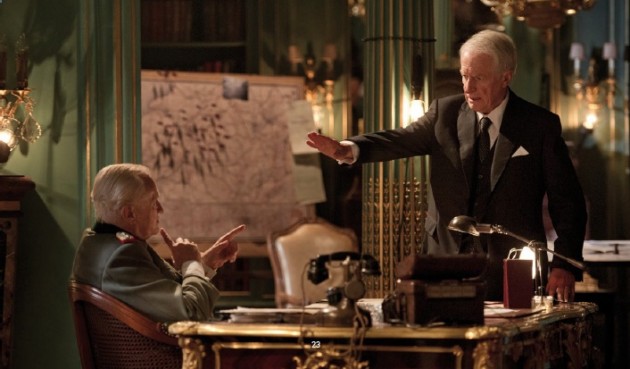
Schlöndorff’s approach keeps the hotel room interactions in the play largely intact, creating visual interest both through the structure of a set that is more elaborate than a stage set would be, and through a use of framing and mise-en-scène that repeatedly compares and contrasts elements of décor with the words and actions they frame. He violates the spatial unity of the play only through the insertion of additional short scenes that give context to and amplify the content of the original text. He further violates the unity by locating the final decision to save Paris on the roof of the hotel setting so as, in Schlöndorff’s own description, to make the sight of the city motivate Choltitz to save it (“Cyril Gély et Volker Schlöndorff pour Diplomatie”). Although a comparison of the film to the published play text reveals a number of rewordings and minor changes, Gély’s dialogue remains for the most part intact. Since the playwright collaborated on the adaptation, one assumes any changes come with his blessing. One would consider this a “faithful” rather than a “transformative” adaptation, in which the changes in no way alter the theatrical focus and intensity of the original.
Two Characters, Two Worldviews
As we have suggested, Schlöndorff’s version retains Gély’s paring of the conflict down to two main characters who exemplify two worldviews. This comparatively minimalist approach makes Choltitz and Nordling not so much real, specific people than personifications of a set of attitudes, values and sensibilities. As most critics of the film have noted, this approach puts much of the weight on the two lead actors, who had performed the roles on stage more than three hundred times (“Cyril Gély et Volker Schlöndorff pour Diplomatie”). Dussollier in particular had shown that he could impart with cinematic life what would traditionally be considered “stage bound” material in Alain Resnais’s Mélo (1986) and Private Fears in Public Places (2006), as well as in the director’s last film, Life of Riley (2014), which premiered at Berlin along with Diplomatie. The challenge of these two main roles in Diplomatie involves suggesting simultaneous attitudes of confidence and anxiety, and of sincerity and duplicity. Even critics who have found shortcomings in the movie’s dramatic structure or factual accuracy have praised the skills of its two stars.
In line with Gély’s play, Schlöndorff’s film conveys almost an element of fantasy to Choltitz and Nordling’s first early-morning encounter. Although the two men historically did have significant meetings involving the exchange of prisoners and a cease-fire, their encounter during the night before Choltitz’s surrender is, as Schlöndorff and Gély have admitted, a fabrication. Nordling is shown entering Choltitz’s quarters by a secret staircase, a narrative device that seems much more credible when one is caught up in the story than when one thinks about it afterwards. Nordling appears to Choltitz after a brief power outage in the manner of a ghost or apparition. One thinks of Hollywood films in which a guardian angel or an embodied moral conscience appears to a character to discuss that character’s moral choices. Gély and Schlöndorff create the feeling that Choltitz and Nordling are really two sides of a single character. When Choltitz talks to Nordling, one wonders if the general is not really debating within himself. Indeed, right before Choltitz and Nordling encounter each other, we see the latter peering through a two-way mirror at the general in conference with his subordinates. In that he knows more than Choltitz about the situation, Nordling is a separate character, but on another level he embodies Choltitz’s conscience.
This level of fantasy and ambiguous identity expands when Nordling explains that Napoleon III had used this staircase for assignations with his mistress. This revelation links the setting to French history and also sets up a metaphor whereby Nordling has come secretly to Choltitz’s chambers to seduce him, not sexually, but with infidelity to the Fuehrer. Diplomatie’s hotel-room setting thus plays with the traditional theatrical trope of creating a location that allows characters to be freed of the limitations of their usual constraining social environments. It is the kind of metaphoric hotel setting used by Schlöndorff’s model, Billy Wilder, so effectively in Avanti! (1972), another stage adaptation. Away from home, Choltitz can toy with insubordination and flirt with infidelity to his Fuehrer, without necessarily going over to the other side of the warrior/diplomat divide.
In describing this bridging of two worlds, Nicolas Bauche has labeled the central opposition in Diplomatie as “the art of war against the art of peace” (“Niels”). If the art of war involves maximized physical force coupled with intelligent strategy, the art of diplomacy employs more subtle means. We all know how, when two people argue, the strongest, most passionate arguments often alienate the person to be persuaded. No one wants to be clobbered by an argument, which is why the most emphatic debater may score points, but still lose an audience. Several times during the film, Choltitz tries to show Nordling the door, only to become re-engaged with the diplomat’s discourse. Nordling scores each time he gets Choltitz to continue the debate, much like the salesman who knows that his first job is to keep the customer in the showroom if the deal is ever to be closed. In their discussions, Nordling switches tactics repeatedly with a variety of approaches. Sometimes his arguments address practical matters, like military strategy; sometimes they are more humanitarian in orientation. Schlöndorff lets Nordling’s nimble negotiations become one of the film’s pleasures for the viewer. The art of diplomacy often becomes one of wearing down or gradually undermining the assumptions of the other.
A telling step in the script’s bridging of the gap between the verbally sparring antagonists occurs when Choltitz tries to counter attack. His argument boils down to “What would you do in my situation?” The very fact that Nordling has evoked this response suggests that he has manipulated Choltitz into the kind of perspective-taking that undermines the absolute rules of the military system. By implication, Choltitz must now consider what others might do in his position. Nordling at first evades answering the question, but when pressed admits, “I don’t know.” Choltitz acknowledges that that is the response he was expecting, but what seems like a point scored for Choltitz is as much a victory for Nordling. The latter may have succeeded in projecting empathy and creating a bond between the two.
Nordling’s project to undermine the principle of blind obedience begins to show signs of success. Consider, for example, the scene, not present in Gély’s play, in which two emissaries of the SS chief, as well as Holocaust architect and chief perpetrator, Heinrich Himmler, want to enforce his recent orders to ransack the Louvre of some of its most prized holdings, an addition based on factual events (Collins and Lapierre, 198-199). Choltitz brushes off the order, to which Himmler’s agents intimate that that could be considered insubordination, or even treason. This scene sets up Choltitz’s change of heart about destroying Paris. If he was willing not to follow orders about the smaller issue, why should it be different with the larger one?
Another, more implied step toward linking the antagonists consists in Nordling becoming, as it were, a reference point for Choltitz. From the very first scenes in the film, Schlöndorff presents Choltitz as the only leader at the top, burdened by difficult decisions. Once Nordling convinces the German general of his neutrality, the Swedish consul may have turned into the primary figure against which Choltitz can check his perceptions of reality. Near the end of their discussion, Choltitz describes his last meeting with Hitler and how unbalanced and out of touch the Fuehrer seemed: “Spittle collected around his lips. His face had become deformed by spasms. And his look . . . his look . . . .” We can see in this admission the process of two worldviews becoming one.
Throughout her book On Violence (1970), Hannah Arendt has made the argument that the use of force is really a sign of weakness, that truly powerful people are able to get what they want through persuasion and civilized negotiation. The situation in Diplomatie is a radical illustration of this principle. If Hitler were truly powerful, he would not need force to occupy Paris, much less want to destroy it. It goes without saying that an intact Paris would have been a crown jewel in the Nazi empire. As history played out, Choltitz’s saving of Paris becomes a form of persuasion whereby he was able to save his own skin after the war. He spent only a couple of years in prison, and some historical commentators have noted that he was never prosecuted for war crimes, despite his involvement with the destruction of Rotterdam and Sevastopol and the execution of a large number of Jews (Neiberg 85; 233).
One might extend the opposition between violent force and gentle diplomacy to the realm of film genre. The classic action film is of course replete with resolving problems through physical means, in battle scenes, shoot-outs, or fist fights. Such action scenes would, of course, involve the element of theater that Aristotle called “spectacle” and that he ranked lowest on the scale of importance, behind plot, character, thought, diction, and melody (684-685). Spectacle is, of course, one of the key elements of nineteenth century melodrama, from which all of the major film genres developed. Along with this emphasis on spectacle came the practice of working with clear and unambiguous standards of right and wrong.
Cinema embraced these aspects of stage melodrama because of the physical, visual nature of the medium. One can surely argue that one of the glories of the film medium is its ability to express moral positions in the purely physical terms of pursuit, attack, and execution of evil and evildoers. But this type of cinema, valued as it should be, is one that parallels the art of warfare. In the realm of spectacle and the action film, bigger and more powerful is often better.
In his classic essay “Designing Pacifist Films,” Paul Goodman develops the argument that there is a contradiction inherent in trying to make a dramatic anti-war film. By its nature, the portrayal of acts of evil violence immediately incites the audience to want to see retribution. This is particularly true in forms of melodrama where good and evil are so clearly defined. It is easy to dramatize war, but much harder to dramatize peace. In Diplomatie, Gély and Schlöndorff have pulled off the trick of making anti-war works because they have provided a largely non-violent resolution to the conflict at hand. The superiority of the choice of non-violence over destruction is reinforced by a closing caption that tells us that Choltitz’s wife and children went unharmed, putting to rest Choltitz’s fears that if he disobeyed orders his family would be killed.
Although Diplomatie is a film about war and takes place during war, one would be wrong to argue for its belonging to the war film genre. Rather, one can compare, as Nicolas Bauche has done, the end result to the films of Alfred Hitchcock, who in films like Rope (1948) and Rear Window (1954) was able to make suspenseful movies structured around fixed, limited locations. Thus Diplomatie is based on understatement and nuance, through characters that do not fully reveal their motivations, either to each other or to the audience. The action film melodrama might be seen as a naively Platonist form of expression, in which goodness is pure and unambiguous to those who have been outside the cave. The strategy of Diplomatie, however, is that of the sophist, that of the moral relativist. Nordling’s very neutrality as the Swedish consul suggests a refusal to make the moral and ethical decision to fight (or support) the Third Reich. Indeed, one historical commentator has objected to how the movie glosses over Nordling’s earlier ties to collaborationist Frenchmen (Nicolas). In the movie’s final dialogue, Nordling discusses with the hotel concierge how he feels quite OK about having been deceptive and manipulative with Choltitz because the outcome was worth it. The moral ends have justified the ethically questionable means.
Diplomatie thus deemphasizes spectacle in favor of talk, drawing one’s attention to the subtleties of dialogue and performance, the two elements that most critics have discussed and praised. In this respect, Schlöndorff follows Goodman’s suggestion, “It is better to err on the side of dryness. The heart is already enlisted“ (204).
Mise-en-scène: Luxury, History, Enlightenment
But it would be a mistake to argue that Schlöndorff has ignored the visual components of cinema. Rather, he has let the spectacle aspect of Diplomatie work in the same subtle way that the narrative does. Although critics and audiences seem to have responded most to the performances and the script, the latter of which won a César award, we can nonetheless see how the elements of Schlöndorff’s mise-en-scène — screen format, set design, framing, lighting, color and camera movement —all contribute to the movie’s arguments.
Schlöndorff has shot Diplomatie in the 2.35:1 Cinemascope format, which he has used only once before, on the Hollywood film Palmetto (1998). But the filmmaker’s strategies of choosing décor, of framing and placing characters on this set show a canny use of the format.
The set used in Diplomatie is oversized and luxurious, much larger than a normal stage set for the play might be. Thus, it is really not until a second viewing of the film that the viewer can begin to become aware of the total geography of Choltitz’s hotel headquarters. Because of the wide-screen format, varying components and points of view of the set are often in the foreground or background of the shots of the actors. The director regularly uses an asymmetrical compositional device of emphasizing one actor on one side of the frame, leaving the other to be filled by imagery from the opulent decor and furnishings around him.
Done in Napoleonic style, these furnishings suggest wealth and privilege, but also the French historical heritage. Reminders of the culture he may be about to destroy surround Choltitz. Schlöndorff himself has commented: “I wanted one to sense that the room has been inhabited by characters other than the general in previous epochs and that the mustiness of this history still floats around these places” (“Interview: Diplomatie”). Yet their very formality creates the strong sense that this is not a domestic space; it is not home. The dominant colors are a grayish blue and gold, colors not far from the dominant tones in Choltitz’s military uniform. The set at times seems like a cage, and the director himself has said he strove to maintain the claustrophobia that imbued the theatrical original (“Cyril Gély et Volker Schlöndorff pour Diplomatie”). There is a sense of a separation from the realities of war and the fighting in the streets below.
Perhaps most remarkable is Diplomatie’s stylized use of lighting. The movie’s lighting design directs intense lights on to the faces of the actors, but also creates pools of light in various places on the set. These bright lights also create shadows, which permit Schlöndorff to move from areas of high-key lighting to those of low-key lighting simply by re-blocking his actors. The result is a room that combines brightness and shadow in a way that suggests ambivalence and contradiction. Schlöndorff and his cameraman have managed to give to color film much of the nuance that can be achieved with black and white film stock. This is clearly not realist lighting, since the bright areas that emphasize the actors’ faces are largely unmotivated by the lighting in the room.
In scenes that take place outside the hotel room, Schlöndorff creates a rhythm where his intense person-to-person encounters are broken up by sequences suggesting the world outside the general’s headquarters, creating a kind of slow-paced parallel editing. These sequences serve as much to create a rhythm as they do to provide context. Schlöndorff creates a further rhythm through the repetition of actions and incidents. Several times in the film Choltitz has asthma attacks between which he contradictorily lights and smokes cigarettes. More than once, an aide will warn Choltitz not to stand too close to the balcony or window for fear of snipers. Periodically we see Choltitz throwing papers into the burning fireplace, clearly suggesting that he is increasingly concerned about covering his tracks. These rhythmic events both point to an alternation between risk taking and safety seeking.
Elements of the mise-en-scène help prepare the film’s dénouement. Near the end of the movie, as we move further into daytime, the look of the images markedly change. This becomes noticeable in the scene where Choltitz has his asthma attack and Nordling takes him to the balcony for some fresh air. We sense Choltitz’s growing dependence on Nordling. At this point in the film, the blue tones of the walls turn less grey. The lighting becomes higher key and even Nordling’s dark suit begins to look navy blue rather than black. In a change of locations that does not occur in the play, the men move to the roof of the hotel to see the Allies coming into the city. It is here that Choltitz makes the decision to annul the bombing plan. The metaphors implicit here are several: the dawning of a new day, the transition from ignorant darkness to light, and even the emergence from a cave of sophism to a sunlight of truth. We never fully know Choltitz’s motives.
Immediately following, Schlöndorff adds a scene in which the character of Hegger, who had been charged with the task of carrying out the explosions, attempts to perform them even over the orders of his general. He is prevented from doing so by a gunshot from a formerly collaborationist French engineer who had been providing technical expertise. Schlöndorff adds to Gély’s narrative a piece of traditional cinematic spectacle in which a villainous character is defeated. Like two other major additions to Gély’s text, the lunch with the Himmler emissaries and the final scene with Nordling and the concierge, Schlöndorff embellishes the stage model either to clarify motives or punctuate a final outcome. Despite these additions, Schlöndorff’s running time is about 15 minutes shorter than the reported running time of the play (Schopbach).
This final assassination scene takes place in an underground location that is completely shut off from daylight. Rather than just opening up the drama to other locations, this scene and its setting extend the movie’s systematic display of a continuum of spaces from those completely contained, to those containing windows to the outside world, to those free spaces out in the open. This contrast of imprisoning enclosures to panoramic freedom parallels the progression within the story of Paris and France from the confinement of occupation to the fresh air of liberation.
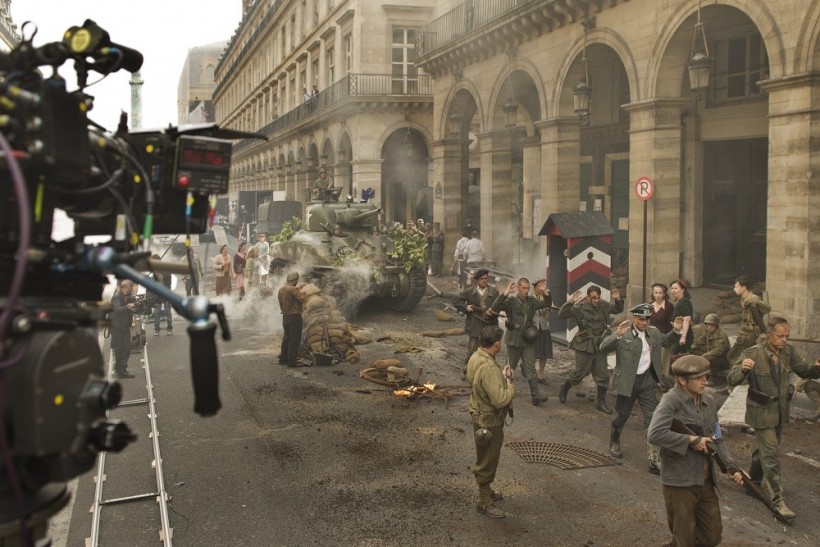
The film itself becomes an example of a happy ending. It suggests the personal significance that the material may have had for Schlöndorff, who came of age in an environment of cooperation between the two countries. Diplomatie concludes with a coda in which a moving camera glides along the Seine and we see Paris at it is today. As the boat carrying the camera moves under bridges that cross the Seine we are reminded of the plans to dynamite those bridges, which we previously saw, before their execution was barred. The riverscape presents evidence of a unified Europe in which French and German citizens can participate together in economic, educational and cultural endeavors. This ending stands in marked contrast to the very beginning of the film, in which we see stock footage of the destruction of Warsaw, gloomily set to a Beethoven accompaniment, documenting the destruction that the German military was capable of and that Nordling dreaded.
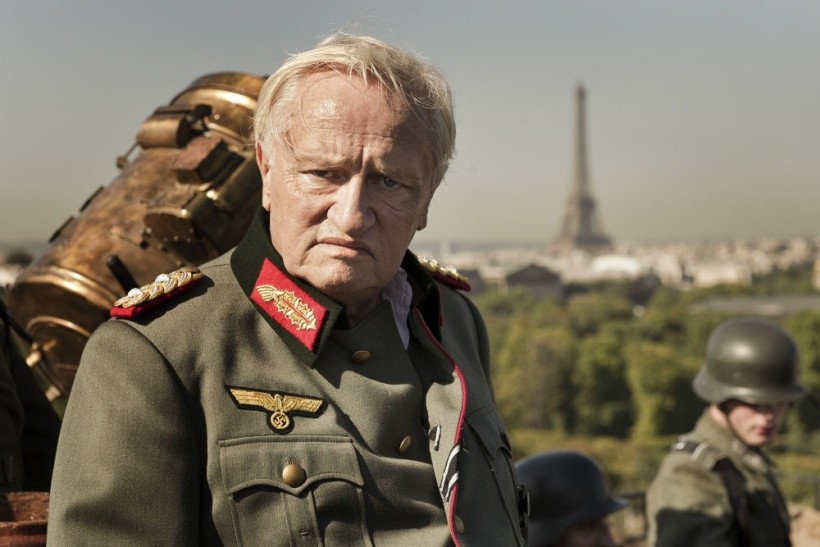
Structuring Absences: Women and Workers
Despite the film’s achievements, it leaves a few nagging questions. Some have been raised by those who question the historical accuracy of the narrative (Buruma); others relate to structuring absences. As in several others of Schlöndorff’s movies, the world presented is an almost entirely masculine one. The two tiny parts given to women are those of a chambermaid and the woman in the hotel, presumably the mistress of a German officer, who insists on the application of her makeup before joining those fleeing the city. An equally conspicuous absence is the glossing-over of the role of the French left. The most we see is the cold-blooded shooting of resistance fighters. This is an absence shared with Clément’s Is Paris Burning?, which remains vague about the specific political leanings of its anti-Nazi rebels. Choltitz and Nordling represent two kinds of masculinity and heroism; however, both are from the elite classes. The heroism of workers and peasants never figures in Diplomatie’s universe.
These simplifications are perhaps forgivable in a work whose scope is limited by a stage model that also overlooks significant elements of history. Yet the filmmaker’s central dramatic opposition may evoke some skepticism when approached from a postmodern perspective. In his Violence: Six Sideways Reflections (2008), Slavoj Žižek, the Slovene theorist, takes issue with the position, articulated by Jean-Marie Muller in a UNESCO document, that “Speaking is the foundation and structure of socialization, and happens to be characterized by the renunciation of violence” (60-61). This either-or statement could indeed be an epigram for Diplomatie’s point of view.
Particularly relevant to Schlöndorff’s film is Žižek‘s argument that language may cause as much violence as it prevents, because the very nature of language creates absolutes and principles that can motivate humans to violence. When Žižek writes the following, one can imagine consequences of the film’s conflict-fraught dialogue: “To begin with, individuals seek power so as not to be dominated by others. But if they are not careful, they can soon find themselves overstepping the limits beyond which they are actually seeking to dominate others.” He continues, “In other words, it is language itself which pushes our desire beyond proper limits, transforming it into ‘a desire that contains the infinite,’ elevating it to an absolute striving that cannot ever be satisfied” (63-65). This danger of wanting the absolute is implicit when Choltitz shudders at the thought of the enraged Hitler, and even he sees in the language of the Third Reich this quest for total world domination. But one can also see it in the cruelty of some resistance fighters who, following the liberation of France, sought revenge against collaborators, an aspect not covered in Gély’s narrative.
But if this is the case, how do Choltitz’s and Nordling’s words and discourse produce violence? Žižek suggest that every ethical system relies on a “gesture of fetishist disavowal.” Every religious movement involves exclusion of some sort; for example, the Buddhist “ethics of solidarity” can foster “learning how to withdraw from too much empathy” (53-54). At the end of Diplomatie, Gély and Schlöndorff structure their discourse so that the very joining of Choltitz and Nordling comes at the cost of the exclusion of those resistance fighters, largely from the working class. On one level Diplomatie anticipates and celebrates the center-right coalition which was to dominate French politics in the early post-World War II era. Where Schlöndorff would point to the peace and prosperity that followed, Žižek would doubtless remind us of the underlying violence experienced by the less privileged classes during that time.
Diplomatie need not be seen as the definitive treatment of the liberation of Paris. Rather, it embodies a number of contradictions evident in the director’s work. Taken as a part of Schlöndorff’s oeuvre, it is one of a series of the director’s explorations of what one interviewer has described as “the resistance of the individual under the regime’s massive pressure” (“Fassbinder”). This common thread about the social and cultural effects of oppressive political systems has run through Schlöndorff’s treatments of not just the Nazi era, but also the historic periods that preceded and followed it. At the same time, there is also a tradition-oriented thread involved in the adaptation of a conventional, actor-oriented, dialogue-heavy, linear, easily accessible play, one that supports a view that Schlöndorff has become increasingly safe and conservative in his aesthetic and ideological discourse. These contradictions and ambiguities may well be the movie’s primary source of energy, making it, like many others of the German filmmaker’s efforts, a movie difficult to put into a single category or box.
Works Cited
Arendt, Hannah. On Violence. San Diego: Harcourt Brace, 1970.
Aristotle. “On Poetics,” in The Works of Aristotle II. Great Books of the Western World 9. Chicago: Encyclopedia Britannica, 681-699.
Bauche, Nicolas. “Niels Arestrup Diplomatie. L’aube de Yalta.” Positif. 637 (March 2014): 7-8.
Buruma, Ian. “The Argument That Saved Paris.” The New York Review of Books: NYR Daily. 15 October 2014.
Collins, Larry and Dominique Lapierre. Is Paris Burning? New York: Simon and Schuster, 1965.
Gély, Cyril et Volker Schlöndorff pour Diplomatie. “Académie” des Arts et Techniques du Cinéma.” Captured: 10.28.2015. Link.
Gély, Cyril. Diplomatie. Espaces littéraires. Berlin: Cornelsen Schulverlage, 2013.
Goodman Paul. “Designing Pacifist Films,” in Robert Hughes, ed. Film: Book 2—Films of Peace and War. Associate editors: Stanley Brown and Carlos Clarens. New York: Grove Press, 1962. 195-204.
Neiberg, Michael. The Blood of Free Men. The Liberation of Paris 1944. New York: Basic Books, 2012.
Nicolas, Ariane. “Les petits arrangements de Diplomatie avec l’Histoire.” ContreChamp francetvinfo. Link’histoire.html.
Schlöndorff, Volker. “Deutsche Schuld und deutsche Verantwortung.” Interview. Berliner Zeitung. 2.13.2014. Captured 02.20.2014. Link deutsche-verantwortung,10809184,26187704.html.
- – -.” Fassbinder war immer hoch konzentriert.” Interview mit Britta Bürger. Deutschlandradio Kultur. 2. 6. 2014. (p. 3 of 4). Link.
- – -. “Interview Diplomatie.” commeaucinema.com. March 3. 2014. P. 2 of 3. Captured 06.18.2014. In the French original: “Je voulais qu’on sente que la chambre a été habitée par d’autres personnages que le général a des époques antérieurs, et que des relants de cette histoire flottent encore dans ces lieux.” Link.
Schopbach, Sandy.“Out and About.” Sandy’s France. Friday, Oct. 21, 211. p. 2 of 3. Captured 06.06.2014. Link.
Žižek, Slavoj. Violence: Six Sideways Reflections. New York: Picador, 2008.


